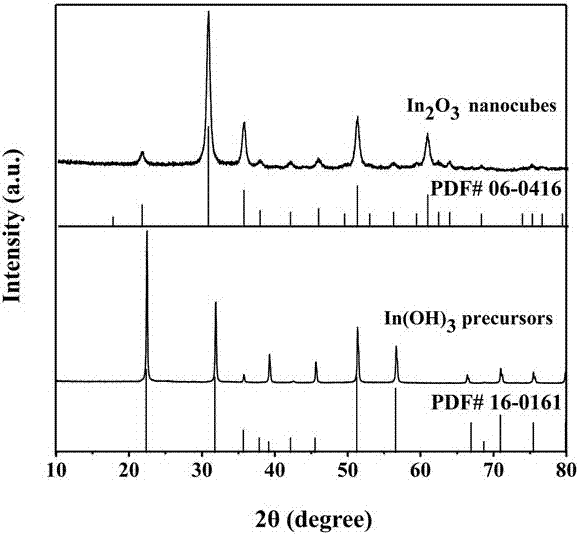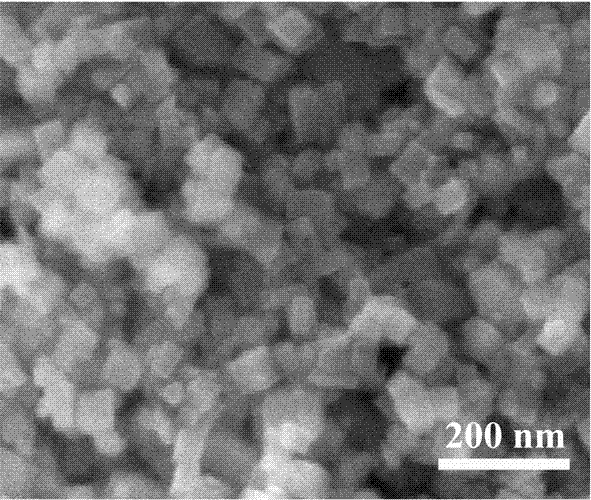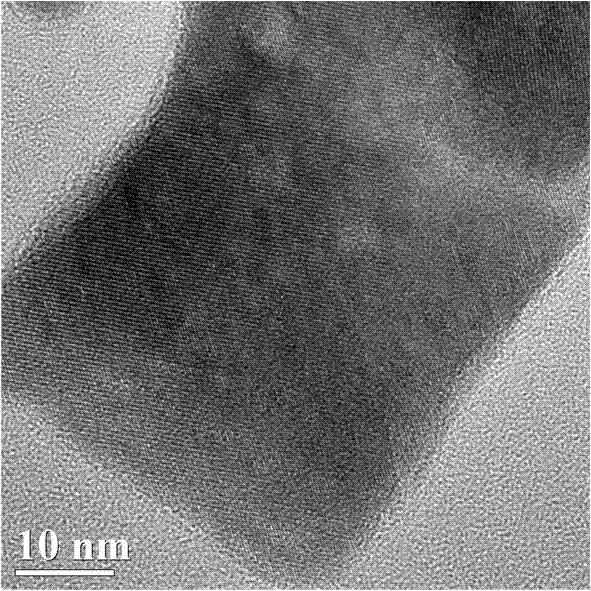Preparation method of porous structured cubic indium oxide gas sensitive material
A porous structure and indium oxide technology, applied in chemical instruments and methods, nanotechnology for materials and surface science, analytical materials, etc., can solve problems such as time-consuming and laborious, destroying fish samples, and complicated operations
- Summary
- Abstract
- Description
- Claims
- Application Information
AI Technical Summary
Problems solved by technology
Method used
Image
Examples
Embodiment 1
[0016] (1) Weigh a certain amount of indium trichloride tetrahydrate and trimethylamine, and dissolve them in 40 mL of deionized water, in which the concentration of indium trichloride tetrahydrate is 0.025 mol / L, and the concentration of trimethylamine is 0.025 mol / L , and the molar ratio of indium trichloride tetrahydrate and trimethylamine is controlled to be 1:1;
[0017] (2) Move the mixed solution obtained in step (1) to a hydrothermal reaction kettle lined with polytetrafluoroethylene, conduct a hydrothermal reaction at 180 °C for 12 h, and then use the hydrothermal reaction product The centrifuge is used for solid-liquid separation, and the obtained solid product is washed several times with deionized water and ethanol;
[0018] (3) The solid product obtained in step (2) was placed in a drying oven, dried at 60 °C, then placed in an alumina crucible and placed in a muffle furnace, and heat-treated at 500 °C for 3 h to obtain a porous indium oxide cubic gas-sensing mate...
Embodiment 2
[0020] (1) Weigh a certain amount of indium trichloride tetrahydrate and trimethylamine, and dissolve them in 40 mL of deionized water, in which the concentration of indium trichloride tetrahydrate is 0.025 mol / L, and the concentration of trimethylamine is 0.05 mol / L , and control the mol ratio of indium trichloride tetrahydrate and trimethylamine to be 1:2;
[0021] (2) Move the mixed solution obtained in step (1) to a hydrothermal reaction kettle lined with polytetrafluoroethylene, conduct a hydrothermal reaction at 180 ºC for 12 h, and then use the hydrothermal reaction product The centrifuge is used for solid-liquid separation, and the obtained solid product is washed several times with deionized water and ethanol;
[0022] (3) The solid product obtained in step (2) was placed in a drying oven, dried at 60 °C, then placed in an alumina crucible and placed in a muffle furnace, and heat-treated at 500 °C for 3 h to obtain a porous indium oxide cubic gas-sensing material . ...
Embodiment 3
[0024] (1) Weigh a certain amount of indium trichloride tetrahydrate and trimethylamine, and dissolve them in 40 mL of deionized water, in which the concentration of indium trichloride tetrahydrate is 0.025 mol / L, and the concentration of trimethylamine is 0.025 mol / L , and the molar ratio of indium trichloride tetrahydrate and trimethylamine is controlled to be 1:1;
[0025] (2) Move the mixed solution obtained in step (1) to a hydrothermal reaction kettle lined with polytetrafluoroethylene, conduct a hydrothermal reaction at 200 °C for 16 h, and then use the product after the hydrothermal reaction The centrifuge is used for solid-liquid separation, and the obtained solid product is washed several times with deionized water and ethanol;
[0026] (3) The solid product obtained in step (2) was placed in a drying oven, dried at 60 °C, then placed in an alumina crucible and placed in a muffle furnace, and heat-treated at 500 °C for 3 h to obtain a porous indium oxide cubic gas-se...
PUM
 Login to View More
Login to View More Abstract
Description
Claims
Application Information
 Login to View More
Login to View More - R&D
- Intellectual Property
- Life Sciences
- Materials
- Tech Scout
- Unparalleled Data Quality
- Higher Quality Content
- 60% Fewer Hallucinations
Browse by: Latest US Patents, China's latest patents, Technical Efficacy Thesaurus, Application Domain, Technology Topic, Popular Technical Reports.
© 2025 PatSnap. All rights reserved.Legal|Privacy policy|Modern Slavery Act Transparency Statement|Sitemap|About US| Contact US: help@patsnap.com



